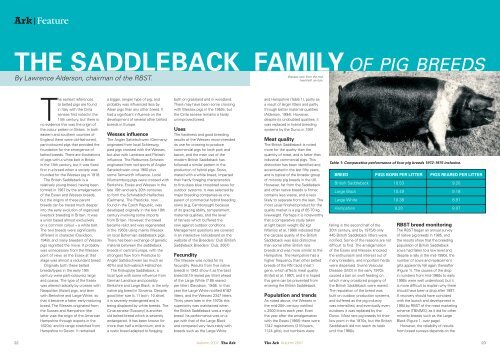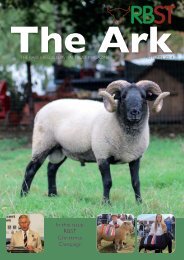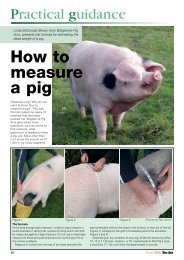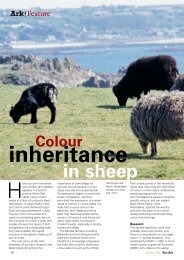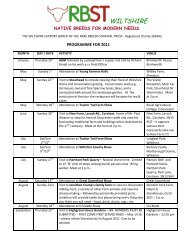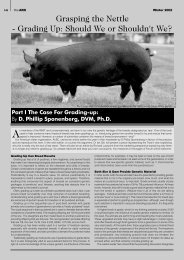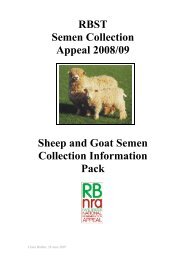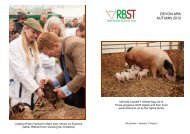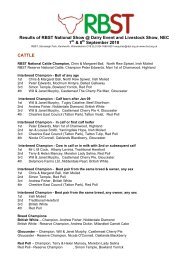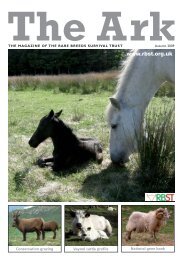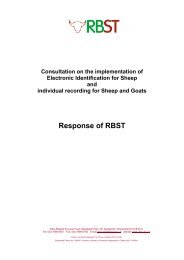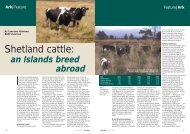the saddleback familyof pig breeds - Rare Breeds Survival Trust
the saddleback familyof pig breeds - Rare Breeds Survival Trust
the saddleback familyof pig breeds - Rare Breeds Survival Trust
You also want an ePaper? Increase the reach of your titles
YUMPU automatically turns print PDFs into web optimized ePapers that Google loves.
Ark|FeatureTHE SADDLEBACK FAMILY OF PIG BREEDSBy Lawrence Alderson, chairman of <strong>the</strong> RBST.Wessex sow from <strong>the</strong> midtwentiethcentury.The earliest referencesto belted <strong>pig</strong>s are foundin Italy with <strong>the</strong> Cintasenese first noted in <strong>the</strong>14th century, but <strong>the</strong>re isno evidence this was <strong>the</strong> origin of<strong>the</strong> colour pattern in Britain. In bo<strong>the</strong>astern and sou<strong>the</strong>rn counties ofEngland <strong>the</strong>re were old-fashioned,parti-coloured <strong>pig</strong>s that provided <strong>the</strong>foundation for <strong>the</strong> emergence ofbelted <strong>breeds</strong>. There are illustrationsof <strong>pig</strong>s with a white belt in Britainin <strong>the</strong> 18th century, but it was fixedfirst in a breed when a society wasfounded for <strong>the</strong> Wessex <strong>pig</strong> in 1918.The British Saddleback is arelatively young breed, having beenformed in 1967 by <strong>the</strong> amalgamationof <strong>the</strong> Essex and Wessex <strong>breeds</strong>,but <strong>the</strong> origins of <strong>the</strong>se parent<strong>breeds</strong> can be traced much deeperinto <strong>the</strong> early evolution of organisedlivestock breeding in Britain. It wasa union based almost exclusivelyon a common colour – a white belt.The two <strong>breeds</strong> were significantlydifferent in character (Davidson,1948), and many breeders of Wessex<strong>pig</strong>s regretted <strong>the</strong> move. It probablywas unnecessary from <strong>the</strong> Wessexpoint of view, as <strong>the</strong> Essex at thatstage was almost a redundant breed.Originally both <strong>the</strong>se belted<strong>breeds</strong>/types in <strong>the</strong> early 19thcentury were parti-coloured, largeand coarse. The type of <strong>the</strong> Essexwas altered radically by crosses withNeapolitan (Asian) <strong>pig</strong>s, and laterwith Berkshire and Large White, sothat it became a fatter early-maturingbreed. The Wessex originated from<strong>the</strong> Sussex and Hampshire (<strong>the</strong>latter was <strong>the</strong> origin of <strong>the</strong> AmericanHampshire through exports in <strong>the</strong>1820s), and its range stretched fromHampshire to Devon. It remaineda bigger, rangier type of <strong>pig</strong>, andprobably was influenced less byAsian <strong>pig</strong>s than any o<strong>the</strong>r breed. Ithad a significant influence on <strong>the</strong>development of several o<strong>the</strong>r belted<strong>breeds</strong> in Europe.Wessex influenceThe Angler Sattelschwein (Germany)originated from local Schleswigpied <strong>pig</strong>s crossed with <strong>the</strong> Wessex,but also with Landrace and Pietraininfluence. The Rotbuntes Schweinoriginated from red sports of AnglerSattelschwein circa 1900 plussome Tamworth influence. LocalWurttemburg <strong>pig</strong>s were crossed withBerkshire, Essex and Wessex in <strong>the</strong>late 19th and early 20th centuriesto form <strong>the</strong> Schwabisch-Hallisches(Germany). The Presticke, nowfound in <strong>the</strong> Czech Republic, wasdeveloped originally in <strong>the</strong> late 19thcentury involving some importsfrom Britain. However, <strong>the</strong> breedbecame relict and was regeneratedin <strong>the</strong> 1950s using mainly Wessexon local Bohemian <strong>saddleback</strong> <strong>pig</strong>s.There has been exchange of geneticmaterial between <strong>the</strong> <strong>saddleback</strong><strong>breeds</strong> in central Europe, with <strong>the</strong>strongest flow from Presticke toAngler Sattelschwien (as much as40%) and Schwabisch-Hallisches.The Krskopolje Saddleback, alocal type with some influence fromGerman Landrace and possiblyBerkshire and Large Black, is <strong>the</strong> onlynative <strong>pig</strong> breed in Slovenia. Despitegood litter size (c.11 born, 10 alive),it is severely endangered and isbeing displaced by white <strong>breeds</strong>. TheCinta senese (Tuscany) is ano<strong>the</strong>rold belted breed which is severelyendangered. It has been known formore than half a millennium, and isa rustic breed adapted to foragingboth on grassland and in woodland.There may have been some crossingwith Wessex <strong>pig</strong>s in <strong>the</strong> 1950s, but<strong>the</strong> Cinta senese remains a hardyunimproved breed.UsesThe hardiness and good breedingresults of <strong>the</strong> Wessex recommendedits use for crossing to producecommercial <strong>pig</strong>s for both pork andbacon, and <strong>the</strong> main use of <strong>the</strong>modern British Saddleback hasfollowed a similar pattern in <strong>the</strong>production of hybrid <strong>pig</strong>s. Sows,mated with a white breed, imparted<strong>the</strong>ir hardy foraging characteristicsto first-class blue crossbred sows foroutdoor systems. It was selected bymajor breeding companies as oneparent of commercial hybrid breedingsows (e.g. Camborough) becauseof its grazing ability, temperament,maternal qualities, and <strong>the</strong> levelof fatness which buffered <strong>the</strong>sow against outdoor conditions.Management questions are coveredin an interactive noticeboard on <strong>the</strong>website of <strong>the</strong> Breeders’ Club (BritishSaddleback Breeders’ Club, 2007)FecundityThe Wessex was noted for itsfecundity. Results from five native<strong>breeds</strong> in 1942 show it as <strong>the</strong> bestbreed (8.19 reared per litter) aheadof <strong>the</strong> Large White (7.85 rearedper litter) (Davidson, 1948). In thatyear <strong>the</strong> Large White notified 6182litters, and <strong>the</strong> Wessex 2347 litters.Thirty years later in <strong>the</strong> 1970s thissuperiority was maintained when<strong>the</strong> British Saddleback was a majorbreed. Its performance was on apar with that of <strong>the</strong> Large Blackand compared very favourably with<strong>breeds</strong> such as <strong>the</strong> Large Whiteand Hampshire (Table 1), partly asa result of larger litters and partlythrough better maternal qualities(Alderson, 1994). However,despite its undoubted qualities, itwas replaced in hybrid breedingsystems by <strong>the</strong> Duroc in 1991.Meat qualityThe British Saddleback is notedmore for <strong>the</strong> quality than <strong>the</strong>quantity of meat, and is fatter thanindustrial commercial <strong>pig</strong>s. Thisdistinction has been identified andaccentuated in <strong>the</strong> last fifty years,and is typical of <strong>the</strong> broader groupof minority <strong>pig</strong> <strong>breeds</strong> in <strong>the</strong> UK.However, fat from <strong>the</strong> Saddlebackand o<strong>the</strong>r native <strong>breeds</strong> is firmer,contains less waste, and is lesslikely to separate from <strong>the</strong> lean. Themost usual finished product for <strong>the</strong>quality market is a <strong>pig</strong> of 65-70 kgliveweight. Perhaps it is noteworthythat a comparative study takenat light bacon weight (62 kg)(Warriss et al, 1990) indicated that<strong>the</strong> carcase quality of <strong>the</strong> BritishSaddleback was less distinctivethan some o<strong>the</strong>r British rare<strong>breeds</strong> and was more similar to <strong>the</strong>Hampshire. The Hampshire has ahigher frequency than o<strong>the</strong>r belted<strong>breeds</strong> of <strong>the</strong> RN (‘acid meat’)gene, which affects meat quality(Enfalt et al, 1997), and it is hopedthis gene can be prevented fromentering <strong>the</strong> British Saddleback.Population and trendsAs noted above, <strong>the</strong> Wessex in<strong>the</strong> mid-20th century notifiedc.2500 litters each year. Even<strong>the</strong> year after <strong>the</strong> amalgamationwith <strong>the</strong> Essex (1968) <strong>the</strong>re were1342 registrations (218 boars,1124 gilts), but numbers wereTable 1: Comparative performance of four <strong>pig</strong> <strong>breeds</strong> 1972-1975 inclusive.BREED PIGS BORN PER LITTER PIGS REARED PER LITTERBritish Saddleback 10.53 9.20Large Black 10.49 9.18Large White 10.38 8.91Hampshire 9.20 8.07falling in <strong>the</strong> second half of <strong>the</strong>20th century, and by 1975/6 only445 British Saddleback litters werenotified. Some of <strong>the</strong> reasons are notdifficult to find. The amalgamationof <strong>the</strong> Essex and Wessex knocked<strong>the</strong> enthusiasm and interest out ofmany breeders, and important herdswere dispersed. Swine VesicularDisease (SVD) in <strong>the</strong> early 1970scaused a ban on swill feeding onwhich many crossbred progeny of<strong>the</strong> British Saddleback were reared.The reputation of <strong>the</strong> breed wasbuilt on outdoor production systems,and suffered as <strong>the</strong> <strong>pig</strong> industrywas intensified, and eventually evenoutdoors it was replaced by <strong>the</strong>Duroc. Most rare <strong>pig</strong> <strong>breeds</strong> hit <strong>the</strong>irlow point in <strong>the</strong> 1970s, but <strong>the</strong> BritishSaddleback did not reach its nadiruntil <strong>the</strong> 1980s.RBST breed monitoringThe RBST began an annual surveyof native <strong>pig</strong> <strong>breeds</strong> in 1985, and<strong>the</strong> results show that <strong>the</strong> breedingpopulation of British Saddlebacksows had fallen to a low level and,despite a rally in <strong>the</strong> mid-1990s, <strong>the</strong>number of sows and replacementgilts apparently fell again <strong>the</strong>reafter(Figure 1). The causes of <strong>the</strong> dropin numbers from mid-1960s to early1990s were well understood, but itis more difficult to explain why <strong>the</strong>reshould have been a drop after 1997.A recovery should have coincidedwith <strong>the</strong> launch and development in1994 by RBST of <strong>the</strong> meat marketingscheme (TBMMS), as it did for o<strong>the</strong>rminority <strong>breeds</strong> such as <strong>the</strong> LargeBlack (Figure 1, over page).However, <strong>the</strong> reliability of resultsfrom breed surveys depends on <strong>the</strong>22 Autumn 2007 The Ark The Ark Autumn 200723
Ark|FeaturePhoto: Peter KingTable 2: Genetic distance between four European belted <strong>pig</strong> <strong>breeds</strong> derived from <strong>the</strong> Wessex.PR AS SH BSPR x .0782 .1543 .1003AS .0782 x .1705 .0936KEYPR = Presticke,AS = Angler SattelschweinSH = Schwabisch_HallischesBS = British Saddleback.SH .1543 .1705 x .1859BS .1003 .0936 .1859 xresponses received. The RBST nowuses annual female registrationsas <strong>the</strong> preferred indicator, and<strong>the</strong> results in 2003-2005 (average370 registrations pa) show thatsurvey numbers in <strong>the</strong> last fewyears probably have significantlyunderstated <strong>the</strong> true situation.The current population is c.600 sows.The RBST procedure of analysis ofannual female registrations will givean accurate picture in <strong>the</strong> future.Belted <strong>breeds</strong>The belted colour pattern is notexclusive to Europe, as it is seen onsome <strong>pig</strong>s in South-East Asia, andits origin is not clear. The genotypefor black belted <strong>pig</strong>s is E D i Be (E Dbeing <strong>the</strong> allele for dominant black,and i Be <strong>the</strong> allele for a white belt)(Alderson & Plastow, 2004), but<strong>the</strong> width of <strong>the</strong> belt is subject topolygenic and epistatic effects thatcan widen <strong>the</strong> belt to cover almost<strong>the</strong> whole body or eliminate italtoge<strong>the</strong>r. The history of <strong>the</strong> breedmight indicate that this shouldbe expected. Both <strong>the</strong> Sussexand Hampshire (ancestors of <strong>the</strong>Wessex) were variable in colour,The Traditional Pig Ark CompanySolidly built,galvanised metal,tanalised timber,polymer ends.Complete withfloor, skids andlifting hooks.Dry and cosy.8’ x 4’ - £325(suitable for 2 Kune Kune)8’ x 6’ - £3658’ x 8’ - £4258’ x 10’ - £475No VAT – Free Delivery(England and Wales)As supplied to River Cottage HQWe offer a personal delivery service on our own transportArks delivered ready for immediate occupation(no assembly required)Tel: 01884 860515Visit: www.<strong>pig</strong>-arks.comand crossing with <strong>the</strong> Neapolitaneliminated <strong>the</strong> belt of <strong>the</strong> Essex in<strong>the</strong> early stages of improvement.DNA analysesSeveral belted <strong>breeds</strong> were includedin a European project (PigBioDiv1),and most of <strong>the</strong>m are related tosome degree. Five <strong>breeds</strong> wereinfluenced to a varying degreeby <strong>the</strong> Wessex, namely BritishSaddleback (BS: UK), Hampshire(USA), Presticke (PR: Czech), AnglerSattelschwein (AS: Germany)and Schwabisch-Hallisches (SH:Germany), and genetic distancesderived from DNA analyses tendedto confirm <strong>the</strong> degree and recencyof this influence (Table 2). The leastrelated were <strong>the</strong> British Saddlebackand Schwabisch-Hallisches.The distances to <strong>the</strong> Cinta seneseand <strong>the</strong> Hampshire were greatestfor all o<strong>the</strong>r <strong>breeds</strong>. This was notunexpected for <strong>the</strong> Cinta senese, avery small isolated population whichstands out as <strong>the</strong> most distinctivebreed, but perhaps it was surprisingto find such a large genetic distancebetween <strong>the</strong> British Saddleback andHampshire and must be explained60050040030020010 00by <strong>the</strong>ir separation for manygenerations.Apart from its expected closerelationship to <strong>the</strong> Presticke andAngler Sattelschwein, <strong>the</strong>re wereinteresting indications of closerelationship of <strong>the</strong> British Saddlebackto particular Pietrain and Landracelines, and it was significantly moreclosely linked to <strong>the</strong> Duroc thanany o<strong>the</strong>r native British breed. Itpossesses several alleles whichare not found in o<strong>the</strong>r Britishminority <strong>breeds</strong>, but are found in <strong>the</strong>Duroc. It had <strong>the</strong> lowest betweenbreeddiversity (ie, <strong>the</strong> leastdistinctiveness) of all <strong>the</strong> minorityBritish <strong>breeds</strong> (Alderson, 2004), andgrading-up programmes will havebeen a significant causal factor.Despite a good spread of bloodlinesin <strong>the</strong> breed, attempts have beenmade to ‘improve’ <strong>the</strong> Saddlebackthrough grading-up. Several femalefamilies (Bountiful, Choice, Charm,Diana, Edloma, Electra, Hea<strong>the</strong>r,Hermione, Hilda, Joyful, Lassie,Lucina, Molly and Twinkle) and sirelines were involved, and this hasdetracted from <strong>the</strong> founder integrityof <strong>the</strong> breed.Figure 1: Population trend for BS and LB <strong>pig</strong>s 1988-2004breed survey three year rolling average for number of giltsretained per annum.BritishSaddlebackLargeBlack1988 1989 1990 19 91 1992 1993 199 4 1995 1996 1997 1998 1999 2000 2001 2002 2003 2004As part of a broader study, relationshipswithin <strong>the</strong> British Saddleback wereanalysed more closely. Small numbersof Wessex and Essex <strong>pig</strong>s wereincluded. The Wessex results wereclearly distinctive from <strong>the</strong> main group,and <strong>the</strong>refore <strong>the</strong> conservation of <strong>the</strong>Wessex as a separate breed in Australiais an important programme. The Essexwas scattered randomly through <strong>the</strong>phylogenetic tree, suggesting that it hasnot survived as a distinct type within <strong>the</strong>current population. A by-product of thisstudy has been <strong>the</strong> development by RBSTof a breed DNA profile which enables <strong>the</strong>assignment of individual animals to <strong>the</strong>breed to be verified.ExportsThe influence of Wessex exports on <strong>the</strong>development of belted <strong>breeds</strong> in o<strong>the</strong>rcountries has been noted above. Whilethis trade expanded <strong>the</strong> ‘belted’ family, italso had a detrimental effect on <strong>the</strong> nativegenetic resources in those countries.A recent renewal of interest in exportscarries <strong>the</strong> same dangers. What effectwill <strong>the</strong> export of British Saddleback toBhutan in 2003 have on <strong>the</strong> native <strong>breeds</strong>?Similarly, it can be considered that <strong>the</strong>recent import of British Saddleback bybreeders of Schwabisch-Hallishes inGermany will change <strong>the</strong> native breed asit is not closely related to <strong>the</strong> British breed(Table 2). The desire to import rare <strong>breeds</strong>should be tempered with knowledge of<strong>the</strong> dangers, and exporting countries thathave ratified <strong>the</strong> CBD must ensure that<strong>breeds</strong> would not impact negatively onnative <strong>breeds</strong> in <strong>the</strong> receiving country(Strauss, 1994).Can lessons be learned?The creation and development of <strong>the</strong>British Saddleback provides many lessonsfrom which we can profit. In particular:1. Breed amalgamation. Unless <strong>the</strong> <strong>breeds</strong>concerned are very closely related <strong>the</strong>result may be <strong>the</strong> loss of one or bothgenotypes ra<strong>the</strong>r than <strong>the</strong>ir preservation.The Essex/Wessex amalgamation probablywas an example.2. DNA profiling can help to identify<strong>breeds</strong>, and groups within a breed.The British Saddleback is less distinctivegenetically than some o<strong>the</strong>r native British<strong>breeds</strong>, and this might result from itsformation by amalgamation, or fromgrading-up programmes, or from illicitintrogression. However, <strong>the</strong> DNA results(albeit numerically small) show that <strong>the</strong>Wessex is a distinct breed currentlyconserved in Australia, whereas <strong>the</strong> Essexresults show no clear distinction from <strong>the</strong>main breed.3. Introgression, whe<strong>the</strong>r by gradingupor o<strong>the</strong>rwise, is unnecessary exceptin rare circumstances and potentiallydamaging for a native endangered breed.It compromises genetic integrity. RBSThas software to help <strong>the</strong> breeders’ club toidentify introgression by DNA profiling.4. Loss of popularity. Is it possible toidentify in advance factors which maylead to loss of popularity? The Essex/Wessex breed amalgamation was adeliberate policy, but could SVD and <strong>the</strong>intensification of <strong>pig</strong> production have beenanticipated and circumvented?5. Exporting a rare breed may endangernative <strong>breeds</strong> in <strong>the</strong> receiving country.The Schwabisch-Hallishes project is anexample of this danger.REFERENCESAlderson L. 1994.The Chance to Survive (3rdedition). 117.Alderson L. 2004.Diversity in European Pigs. ArkXXXII, 4, 28-33.Alderson GLH and PlastowGS. 2004.Use of DNA markers to assistwith product traceability andpedigree and <strong>the</strong>ir role in breedconservation. AGRI 35, 1-7.British SaddlebackBreeders’ Club.Website www.<strong>saddleback</strong>s.org.uk.Davidson HR. 1948.The Production and Marketing ofPigs. 332.Enfalt AC et al. 1997.Estimated frequency of <strong>the</strong> RNallelein Swedish Hampshire <strong>pig</strong>s.J. of An. Sci. 75, 11, 2924-2935.Strauss MS. 1994.Implications of <strong>the</strong> Convention onBiological Diversity. FAO workinggroup report.Warriss PD et al. 1990.The thickness and quality ofbackfat in various <strong>pig</strong> <strong>breeds</strong> and<strong>the</strong>ir relationship to intramuscularfat and <strong>the</strong> setting of joints from<strong>the</strong> carcase. Meat Science,28, 21-29.24 Autumn 2007 The Ark The Ark Autumn 200725


